Trailer Bill of Sale Form
A trailer bill of sale is a legal form that officially confirms the transfer of a trailer to another person or entity. Such a document is advantageous both for the seller and the buyer since a bill of sale for a trailer ensures you have a record of your sale, which is legally obligatory during a title transfer and may be used to protect your rights.
Over the course of our article, you will learn all important information on the completion of a bill of sale, how to form the price for your carrier correctly, and what types of such a conveyance are in demand in the United States.
The definition of a trailer describes it as a vehicle of a large size intended for being transported by truck or hauler or a furnished transport means drawn by a truck or automobile and used as a residential space or working office when parked. Essentially, a trailer is a transport vehicle, so if you want to sell it or perform the ownership transfer, a corresponding bill of sale will come in handy that will guarantee the security of the transaction between you and the buyer. If you are the one who wishes to purchase a trailer, you should also protect the transaction by requiring the seller to submit the trailer bill of sale document.
Why Use a Trailer Bill of Sale?
In brief, such a state document helps to protect the rights of both the seller and buyer if any issues occur. Due to the prevailing number of buying and selling deals between private individuals being realized using cash, it may be difficult to prove that the item was obtained or paid for without accurate document provision.
Looking at the document on the seller’s side, you’ll see that the trailer bill of sale is crucial since it provides evidence of how much money the purchaser has pledged to pay, as well as the confirmation that the customer has accepted the liability for the trailer. Thus, the dealer will escape any financial liability in case the trailer gets in an accident later.
As for the customer’s side, such a bill of sale is also very critical when you are acquiring a trailer. In this situation, the trailer bill of sale gives proof that the seller of this means of transport legitimately transferred the title to you and that from now on, you are the owner of this trailer. It can also help the buyer to certify that the trailer was promised to be in a particular state during the purchase.
Trailer Bill of Sale Form Details
| Document Name | Trailer Bill of Sale Form |
| Can Be Used For | Utility, Boat, Horse, Travel, Camper, Homemade, Towing, and Cargo Trailers |
| Avg. Time to Fill Out | 10 minutes |
| # of Fillable Fields | 58 |
| Available Formats | Adobe PDF; Microsoft Word |
Can I Create a Trailer Bill of Sale Online?
By analogy with all legal documentation, a trailer bill of sale can be quite challenging to compose on your own. For this reason, we provide you with a special trailer bill of sale template that you may download at our website to write your own trailer bill of sale. Mind that all downloads of our example of the bill of sale form are free of charge and all of our trailer sale forms are top quality.
By using our templates, you will get the opportunity to include your special terms and conditions without getting perplexed by complex legal terminology and language. The free bill of sale form for selling or purchasing a trailer is available in PDF and Microsoft Word formats. Hence, you are free to add any related information you want into the template, fill out all the necessary fields, and then print it out.
Besides that, you can utilize our stage-by-stage builder to create a highly customized form of a trailer bill of sale in under 10 minutes.
Of course, there is also an option to contact a lawyer for proper consultation on the relevant topic, but it would cost you some money. The price for such a service varies from a law firm to a law firm as well as their warranties and version of the offered bill of sale form documents. Plus, you will have to disclose private information like your street address, the state of your residence, the VIN of your transport means, and other vital details.
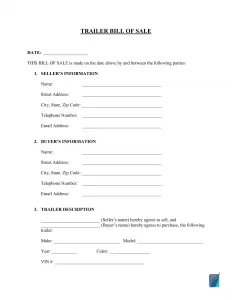
How Do I Sell a Trailer?
If you decided to put your trailer up for sale but you have no idea where to start this adventurous event or how to form a fair price for it, follow our simple step-by-step instructions below.
Step 1. Describe the Type of Trailer
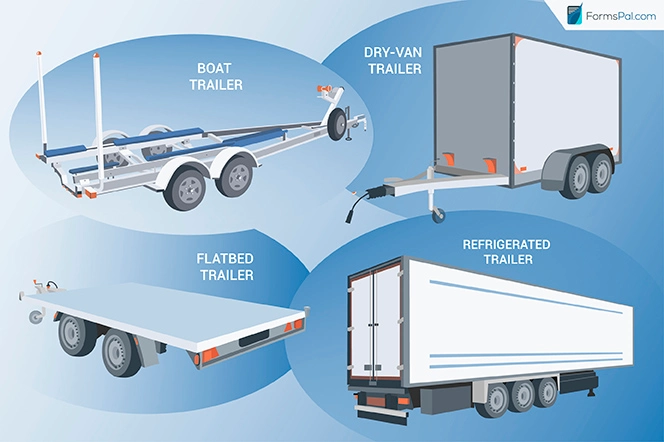
The trailers’ worth may vary significantly from several hundred to thousands of US dollars based on the type of such a vehicle. Similarly, the characteristics of the trailers range from model to model, including their registration details and purposes of use. The trailers can be very different depending on their designated purpose and structure, but the most popular kinds in the United States are:
- Flatbed trailers
- Dry-van (enclosed) trailers
- Refrigerated trailers
- Vehicle-carrying trailers
After you figure out the type of such a vehicle, it is advised to learn its length and year of manufacture as well as the number of axels, maximum weight in pounds, and other essential characteristics (like vehicle identification number) that might be useful to a potential buyer. Collect all of the necessary information about it.
Step 2. Set the Value of the Trailer
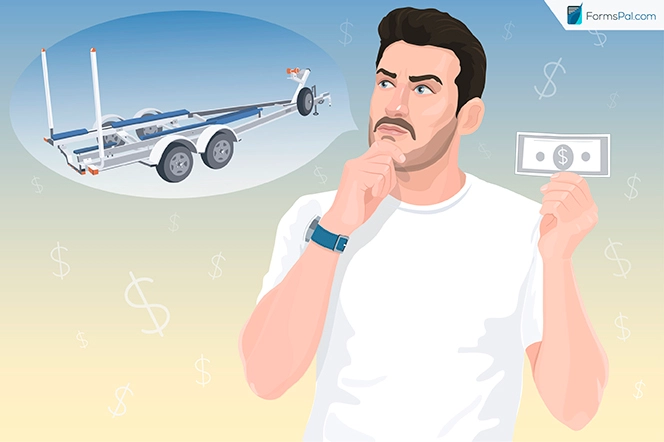
In contrast to conventional means of transportation, trailers are produced in various forms and dimensions. Deciding on a price hinges upon the type of the vehicle in the first place, more than upon the name of its manufacturer, so before the purchase, it’s recommended to collect information that will potentially help you out with this task. It is preferable to view similar transport means to put up on the market in your area when pondering on the price of your trailer and compare the prices of the discovered options. Most likely, you won’t find a “perfect match,” but, at any rate, you will find a comparable trailer and figure out the possible price of yours.
Step 3. Offer Your Trailer for Sale
Prior to listing your trailer for sale, it would be best to examine in which condition your property is, especially if it’s been on the road for a long time. If its state requires so, wash its exteriors, repair any damages (e.g., remove the rust), and clean the internal premise of any garbage. In short, make sure that the condition of your transportation means is satisfactory so that the purchaser wouldn’t question it. Thus, you will ensure yourself with the best photos when posting your ad on different websites. It is better to address the following online and offline ways for listing your ad:
Online choices:
- Specialized trailer resources (e.g., BuyMyTrailer.com)
- Craigslist
- eBay
Offline variants:
- Newspaper with advertising booklet
- Newsletters or local bulletin boards
Step 4. Meet With Prospective Buyers
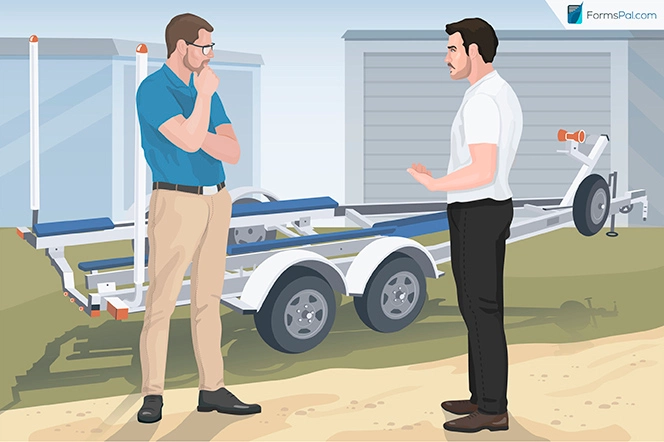
Do not neglect meeting with potential buyers hoping that the vehicle will be sold to someone for the set price. When talking to any individual who wishes to purchase your trailer, make sure they are qualified enough to operate and maintain such motor vehicles. Also, question if they hold the required amount of cash to finish the sale to eliminate the possibility of being involved in a fraud. The majority of lenders will not provide the person with a loan for buying a trailer unless the boat or other vehicle is part of the sale.
According to the trailer’s documentation that the seller has in their possession, you may also settle on the price, but only if the seller has all essential vehicle-related papers with their signature on their hands.
Step 5. Complete a Trailer Bill Of Sale

When filling out the bill of sale form, ensure that the following information is featured in it:
- Purchase price in dollars (U.S.)
- Customer’s full name and email address
- Name seller and their email address
- Trailer details (make, model, 17-character VIN (vehicle identification number), and other essential details)
- Date of the deal
- The signature of the witness, their name, and date
- The signatures of the parties engaged in the sale
- Notarized confirmation (if relevant)
To confirm the identity of the dealer and the buyer, the two of them take government-issued identification cards or driver’s licenses with them.
Step 6. Notify the State of Your Acquisition and Register It

If the trailer is in operation, the buyer will need to have the ownership cleared and transferred by the dealer before applying for registration. Be sure to register your newly-acquired trailer within a period from 5 to 30 days. The list of requirements contains the necessity to present the trailer bill of sale, title, registration statement, and any sales tax to the local licensing office, also known as the “DMV.” At this step, the deal is accomplished, and parties shouldn’t have any obligations to one another unless it is established in the trailer bill of sale.
How to write a Trailer Bill of Sale?
The guidelines here are centered around our sample trailer bill of sale template. But, if there’s a document available from your local authorities, it is always recommended to use it during the transaction.
Step 1: Indicate the bill of sale creation date.

Step 2: Type in the details of all parties (seller and purchaser):
- Name
- Street
- City
- State
- Postal code
- Phone number
- Email

Step 3: Fill in the information about the trailer that you are trying to sell:
- Manufacturer
- Trailer model
- Color
- Year
- VIN (if applicable)

Step 4: At this point, you will need to choose the way you will be given money for the offer.
This part also requires specifying the date of the purchase and the full sum agreed upon by both parties of the transaction. After that has been handled, you need to indicate the way of transaction:
- One-time payment. One of the straightforward methods: on the same day, the buyer gets the motor vehicle delivered to them and pays off the full amount of money.
- Gift with no consideration. This option is the seller giving a gift to the purchaser without any form of payment.
- In installment payments. Specify the down payment amount as well as the date it needs to be given, along with the date by which the full sum has to be transferred to the seller.
The next step is selecting the way of payment:
- Cash
- Check
- Cashier’s cheque
- Money order
As a final point, specify whether the purchase cost includes all applicable taxes.
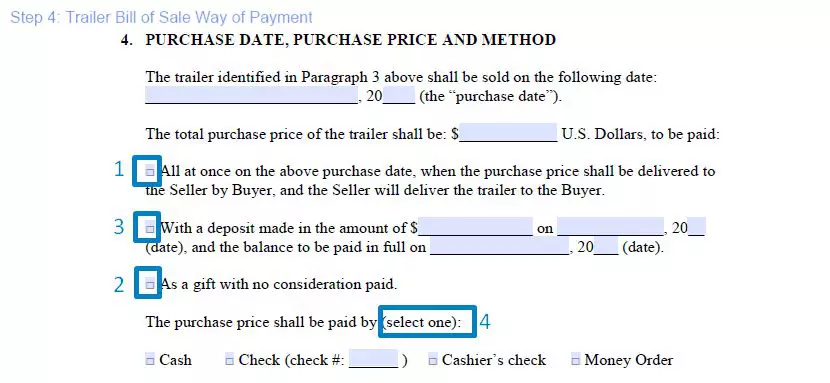
Step 5: Read through standard provisions and make sure that both parties are aware of them.
The seller confirms that they are indeed the owner of the trailer described in the document and they have the right to sell it based on the price in the form. The seller also confirms that there are no liens on the trailer and that the information provided in the Bill of Sale is true, accurate and complete to the best of their knowledge
These generally state that the buyer obtains the trailer in “as-is” condition and is responsible for it once the purchase is completed.

Step 6: Now, the document has to be signed.
The buyer’s signature is usually not mandatory. Nonetheless, you’ll be more protected from legal problems if both sides sign the form. You may additionally have one or a few witnesses confirm the transaction.
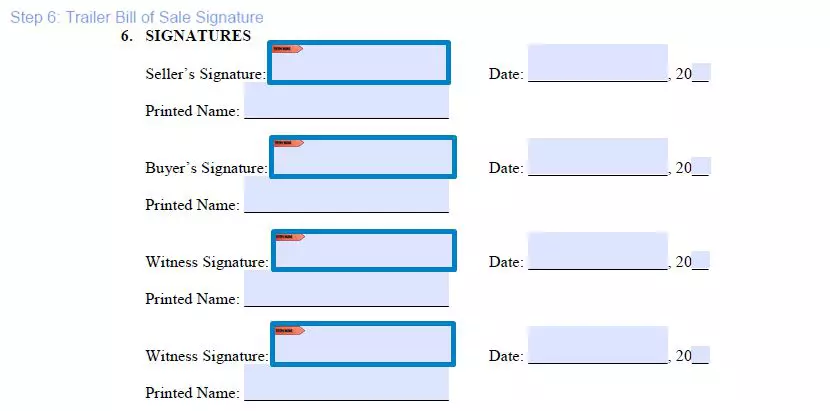
Step 7: Use the assistance of a notary public
Even though notarization is rarely required, it can serve as one more way to guard against legal issues.
If the trailer has a VIN then the original document should be given to the purchaser as they will need it to obtain a title to their newly bought vehicle. There are two ways here: you need to either fill out and sign a pair of identical documents or get a duplicate for the seller to have.



